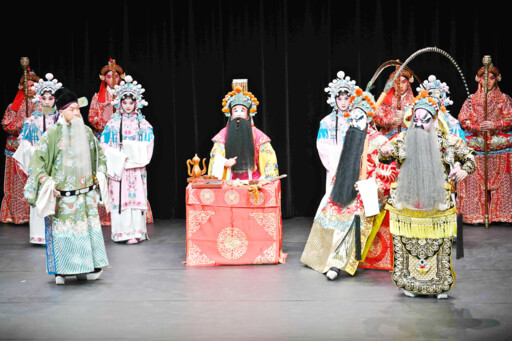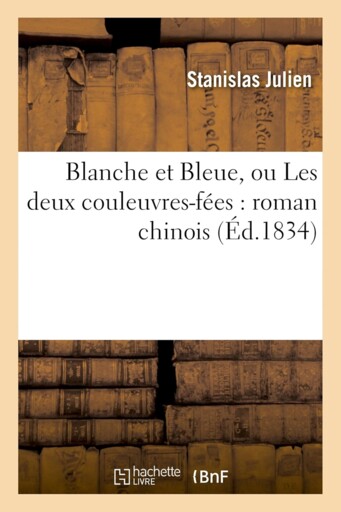


‘Chinese story’ as method driving new perspectives in world literature

A scene from the opening performance — the Peking Opera The Orphan of Zhao — at the 9th Paris Chinese Opera Festival, held at the Guimet Museum in Paris on November 6, 2024. The festival was co-hosted by the China Cultural Center in Paris and China’s National Academy of Chinese Theatre Arts.Photo: IC PHOTO

FILE PHOTO: Blanche et Bleue, ou Les deux couleuvres-fées is a French translation of the classic Chinese folktale “The Legend of the White Snake” by French sinologist Stanislas Julien in the 19th century.
The “Chinese story” is rooted in China’s historical context, carries China’s cultural genes, is grounded in the Chinese experience, and embodies Chinese philosophy. Through a distinctly Chinese narrative, it highlights Chinese aesthetics. As the essence of Chinese civilization, it represents the subjectivity and creativity of the Chinese spirit. The Chinese story gathers the shared experiences and emotions of the Chinese people, reflecting their ideas, customs, ways of life, and spiritual temperament. It is a record of the events and developmental processes within the multi-ethnic community of the Chinese nation, and amid historical change it demonstrates vivid contemporaneity, realism, and innovation. It possesses not only historical depth, but also present-day texture, along with rich cultural and political implications
New type of discourse with Chinese characteristics
Through creative transformation and innovative development, the Chinese story has also become a vital carrier of China’s distinctive institutions, its path to modernization, and its international discourse power. As a narrative framework, the Chinese story has been cited, interpreted, translated, adapted, and transformed in world literature, circulating with classical, national, and global qualities. It is not merely a story about China or a story set in China; rather, it originates in China yet belongs to the world.
In the process of dissemination, the Chinese story has been repeatedly cited and reinterpreted, giving rise to “new stories” with a global dimension, integrating into complex world narratives. Chinese stories are not self-evident clichés, externalized concepts, or pre-scripted historical allegories. Rather, they reflect the nation’s spirit, cultural essence, and the values of the times—they are treasures continuously excavated, constructed, and innovated.
By establishing the Chinese story as both method and standpoint, we can explore a new type of discourse with distinctive Chinese characteristics. This involves systematically studying—through intellectual archaeology—the motivations, patterns, forms, and strategies by which world literature cites and interprets Chinese stories; constructing a global genealogy of the Chinese story while revealing the cultural mechanisms of world literature; and connecting insights from folklore, sociology, cultural studies, communication studies, and anthropology.
Within world literature, this approach investigates the mechanisms of knowledge production surrounding Chinese stories, including discursive, communicative, and motivational mechanisms, highlighting the driving force and effectiveness of Chinese stories in advancing modern civilization.
Highlighting global relevance of Chinese culture
The significance of treating the Chinese story as a method lies in enhancing the subjectivity of Chinese culture within a globalized and multicultural context, while emphasizing its meaning and value to the world. Whether in the form of literary, political, cultural, or philosophical texts, Chinese stories ultimately evolve into intellectual resources and knowledge-driven forces capable of transforming reality. As one of the key sources of global knowledge, China can influence international knowledge production through the dissemination of the Chinese story worldwide, offering a Chinese lens for examining and interpreting world literature.
It should be noted that simply tracing the dissemination and scale of Chinese stories in Western knowledge systems and discursive narratives does not fully reveal their significance. Likewise, the motives behind translation, the content of adaptations, and their influence cannot be captured by heat maps or quantitative measures alone. By employing digital humanities techniques to strengthen empirical research on large volumes of texts, and by clarifying intertextuality, influence, and the contexts of discursive reproduction, we can better present the multidimensional and dynamic presence of Chinese discourse in world literature. Such an approach also supports the creative transformation of traditional Chinese cultural theories and discursive resources.
Through intercultural exchange and mutual learning, cultural biases can be addressed and civilizational divides bridged. Such efforts help convey the positive values and core cultural elements of China to the world, underscoring the influence and shared significance of Chinese discourse within global literature and culture.
Transcending linguistic and national boundaries
The Chinese story is not only a vehicle for literary, intellectual, and ideological narratives, but also a field and method for understanding the relationship between self and other. From this perspective, we can examine the roles that Chinese discourse has played, and may continue to play, in world literature, as well as how it participates in human knowledge production and in social and civilizational development.
Taking the Chinese story The Orphan of Zhao as a typical example, its plot has been repeatedly adapted across different historical and cultural contexts, transcending linguistic and national boundaries to enter world literature and generate a rich variety of “new stories.” This process demonstrates both the universality of literary aesthetics and the diversity of motives and modes of adaptation in different countries. Examples include the British political satire The Chinese Orphan: An Historical Tragedy (William Hatchett), the French Enlightenment drama L’Orphelin de la Chine (Voltaire), the Irish patriotic celebration The Orphan of China (Arthur Murphy), the German Bildungsroman Der goldene Spiegel (Christoph Martin Wieland), and the Japanese kabuki play “Sugawara Denju Tenarai Kagami,” which blends Confucian morality with the samurai spirit.
Thus, in the history of translation, adaptation, and reinterpretation, The Orphan of Zhao not only demonstrates the creative vitality of Chinese stories, but also reveals the diverse ways in which world literature has interpreted Chinese Confucian ethics and moral values. At the same time, the global dissemination of The Orphan of Zhao is neither linear nor uniform; it is at once expansive, cumulative, and transformative.
Its expansiveness is evident in the spread of texts. Beginning with the French missionary Joseph Henri Marie de Prémare’s translation, The Orphan of Zhao was adapted into novels, plays, and other forms, and translated into multiple languages, including English, German, Italian, Russian, Polish, and Spanish. Its cumulative nature is reflected in layered dissemination. Voltaire’s adaptation, L’Orphelin de la Chine, became a widely cited derivative text in 18th-century Europe, spawning at least four further adaptations and six translations, circulating as bestsellers or stage performances in various countries. After the 1770s, the reception of The Orphan of Zhao shifted from Britain and France to Germany and Russia, where it exerted considerable influence, particularly among the Russian court and upper classes. Its transformative nature emerges in the adaptation process. Dramatic characters, story structure, and temporal settings were reconfigured, and as the story interacted with foreign cultures, it absorbed external elements and became localized.
In sum, The Orphan of Zhao presents a narrative tapestry that is classical, romantic, modern, national, and global, interweaving multiple dimensions. To study the global genealogy of Chinese stories, we must look beyond the international travels of a single text and adopt a broader methodological perspective. The story is not the ultimate product of knowledge production, but the starting point for knowledge reproduction.
In their global dissemination and evolution, Chinese stories cross temporal, spatial, and cognitive boundaries, giving rise to variant texts with worldwide reach. In different historical and cultural contexts, these stories are continually reinterpreted, demonstrating their role as knowledge-driven forces in shaping world civilization. For example, “The Legend of the White Snake” entered the West in 1833 through French sinologist Stanislas Julien’s translation. In the process of Sino-Western cultural exchange, it has been creatively translated, cited, interpreted, and adapted into multiple languages, including English, French, German, Polish, Croatian, Albanian, and Macedonian.
Over nearly 200 years of circulation, “The Legend of the White Snake” has carried diverse narrative functions—ranging from folklore documentation and moral instruction to political empowerment and philosophical reflection. It has transcended linguistic barriers, connected with new artistic forms and cultural modalities across time and space, and through multimodal and cross-media dissemination, achieved dynamic meaning reconstruction, emotional re-creation, and ethical restructuring, generating a rich and shared cultural imagination.
Transforming from object of study into method
Approaching world literature through the lens of the Chinese story begins with methodologizing the story itself. This involves relativizing European standards, examining world literature as an object, and seeking to reconstruct a new historical and theoretical perspective. By using the Chinese story as a medium, reference point, perspective, and rationale, this approach enriches the global literary landscape and asserts Chinese cultural subjectivity in a multicultural, globalized context. It also enables the construction of a world genealogy of Chinese stories and the identification of the methods by which they circulate globally, revealing the mechanisms of Chinese discourse on a worldwide scale.
World literature research that treats the Chinese story as method does not seek Chinese exceptions or adaptations within Western discursive systems. Rather, it investigates the formation of the Chinese story’s subjectivity, embedding Chinese cultural agency within global knowledge frameworks, moving beyond simplistic East–West binaries, and resisting an overemphasis on “regional specificity.” This approach generates a “critical Chinese discourse,” exploring how to intervene in, participate in, and organize Chinese knowledge production, helping Chinese stories move from the margins to the center, and promoting a paradigm shift in Chinese knowledge production.
In summary, using the Chinese story as a method in world literature research transforms the Chinese story from an object of study into a methodological tool. At the methodological level, it questions Western models, turning the Chinese story into both path and field for understanding the world and reflecting on Chinese culture. This represents a shift in research stance, a reorientation of perspective, and a paradigm shift, as well as a mode of critical and equal dialogue. Through complementary, comparative, and mutually validating engagement with diverse discourses, it reshapes the global knowledge system.
Zhang Fan is a professor from the Institute of Literary Studies at Shanghai International Studies University.
Editor:Yu Hui
Copyright©2023 CSSN All Rights Reserved